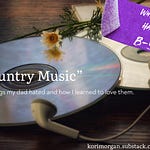As Sam said in The Return of the King, “Well. I’m back.”
I’m truly sorry for disappearing without warning. I’ve gotten a few concerned emails. But as we all know, life happens a lot, and sometimes, we have to put everything on hold.
I had a lot of plans for May. Almost none of them have happened because at the beginning of the month, I threw my back out, and it has been a long crawl ever since. (For a while, that was literal.)
For my return, I tried to write a piece that explained what happened in more detail and even used biting humor in the style of my hero, Flannery O’Connor, who knew something about being laid up with pain.
But honestly, this whole thing has been kind of traumatic, and I quickly discovered that writing about it isn’t a good idea. Not right now anyway.
So, I don’t want to talk about my injury. Instead, I want to talk about The Sound of Music.
We watched it while I was recovering. Twice. Initially, I just wanted a feel-good story of hope to encourage me during the week and a half I slept on the couch (our mattress was hanging on by a thread, which was part of the problem).
Curtis decided to join me. He hadn’t seen it in years and was delighted, so much so that the following evening, he said he wanted to watch it again.
I’ll never turn down a double viewing of The Sound of Music. Apart from my theatre professor in college, I don’t know anyone who would.
I don’t recall seeing The Sound of Music for the first time. Like the Beatles, it was one of those things that I seem to have been born knowing about.
In my first real memory of it, I’m five years old, spending an afternoon with my mom downtown by the Cuyahoga River in my hometown of Kent, Ohio. We wander the walkway next to the water, which smells of wet earth and mud, looking at the turtles and fish.
On our way home, we walk by the old mill that has been defunct for years and has now morphed into a place for college kids to hang out and smoke. Someone has graffitied the side of the building with a cartoonish face bearing a harsh, jagged grimace. Something about it terrifies me, and I immediately want to go home.
Back in my parents’ bedroom, I jump into bed and hide under the covers, terrified that the thing on the side of the building will emerge from the wall fully formed and three-dimensional and follow us home.
Mom puts on The Sound of Music soundtrack on vinyl. We listen to “How Do You Solve a Problem Like Maria,” “Do Re Me,” and “My Favorite Things,” the melodies coaxing me out of hiding, as if Maria von Trapp herself enters the room and tells me it’s okay to come out.
My favorite part of the movie was the puppet theatre scene, where Maria and the children act out “The Lonely Goatherd” with human and goat marionettes. We had a copy of the movie on Betamax and I replayed that part so many times that to this day, when Maria stands in the shadows of the stairway as Captain von Trapp says, “I need you—I ask you—to stay” and she triumphantly claps her hands, I feel a twinge of excitement.
I recall making my own versions of the puppets out of cardboard and stringing them over the ornate bannister in my parents’ turn-of-the-century home. It didn’t have quite the same effect.
There were, however, some morally ambiguous aspects of my youthful Sound of Music fascination—namely, that I thought Baroness Schrader had better clothes than Maria. I was obsessed with that polka dot dress and red suit she wears when she arrives at the von Trapp villa for the first time.
I thought the Baroness was beautiful. But five-year-olds aren’t always the best judges of character, of course. Also, director Robert Wise cut out that song from the original Broadway production that outs the Baroness as a Nazi sympathizer.
Interestingly, just as I don’t recall ever being introduced to The Sound of Music, I don’t remember the moment I realized its dark historical backdrop.
It must have happened after age eleven because that’s when I first learned about the Holocaust. My mom took me to see a production of The Diary of Anne Frank at the high school, which several of her students starred in. I was captivated. Anne was a bit older than I, but in most respects, she was just like me: creative and passionate about words.
But when my mom gently explained what happened to Anne and the citizens of the Secret Annex, I was baffled by how anyone could hate people so much that they wanted them dead.
Surely, I recognized that the same evil that drove the Franks into hiding drove the von Trapps out of their homeland.
Richard Rodgers and Oscar Hammerstein III had a brilliant ability to weave complex themes into their work. South Pacific confronts interracial relationships. The King and I deals with the difficulty of overcoming cultural barriers. And although the subtext is buried underneath the musical’s triumphant title anthem, Oklahoma grapples with domestic and mental abuse.
What I love about The Sound of Music is that it celebrates life, hope, and beauty while not flinching from the darkness.
It makes me think of Paul’s words in Romans 12:12—“Rejoicing in hope, persevering in affliction, being devoted to prayer.”
Several years back, I read a macabre piece of trivia about this movie. During the Cold War, the BBC had the movie on deck to air in the event of a nuclear strike to “improve morale.”
I can’t watch The Sound of Music without this little factoid in mind. Would the story of hope and perseverance hold up in a moment where the world’s survival hung in the balance? After all, the von Trapps escaped over the mountains. But there is no escape from a nuclear winter.
Fortunately, that scenario never transpired. But there’s a reason so many people I know call it their comfort movie. One of my friends got through the death of her mother by watching it on repeat, and a friend from college binge-watched it during the pandemic.
The beauty of The Sound of Music is that hope and beauty are so heavily front-loaded that they eclipse the evil haunting its corners.
These are things a five-year-old hiding under a quilt while listening to her mom’s vinyl copy of the soundtrack can’t understand.
But with every light, momentary affliction, hope reveals itself more clearly. And for Christians, this means the eternal weight of glory that our struggles prepare us for.
I’m excited to be back here on Substack, so let’s have some fun. Drop your favorite Sound of Music memory in the comments.













Share this post